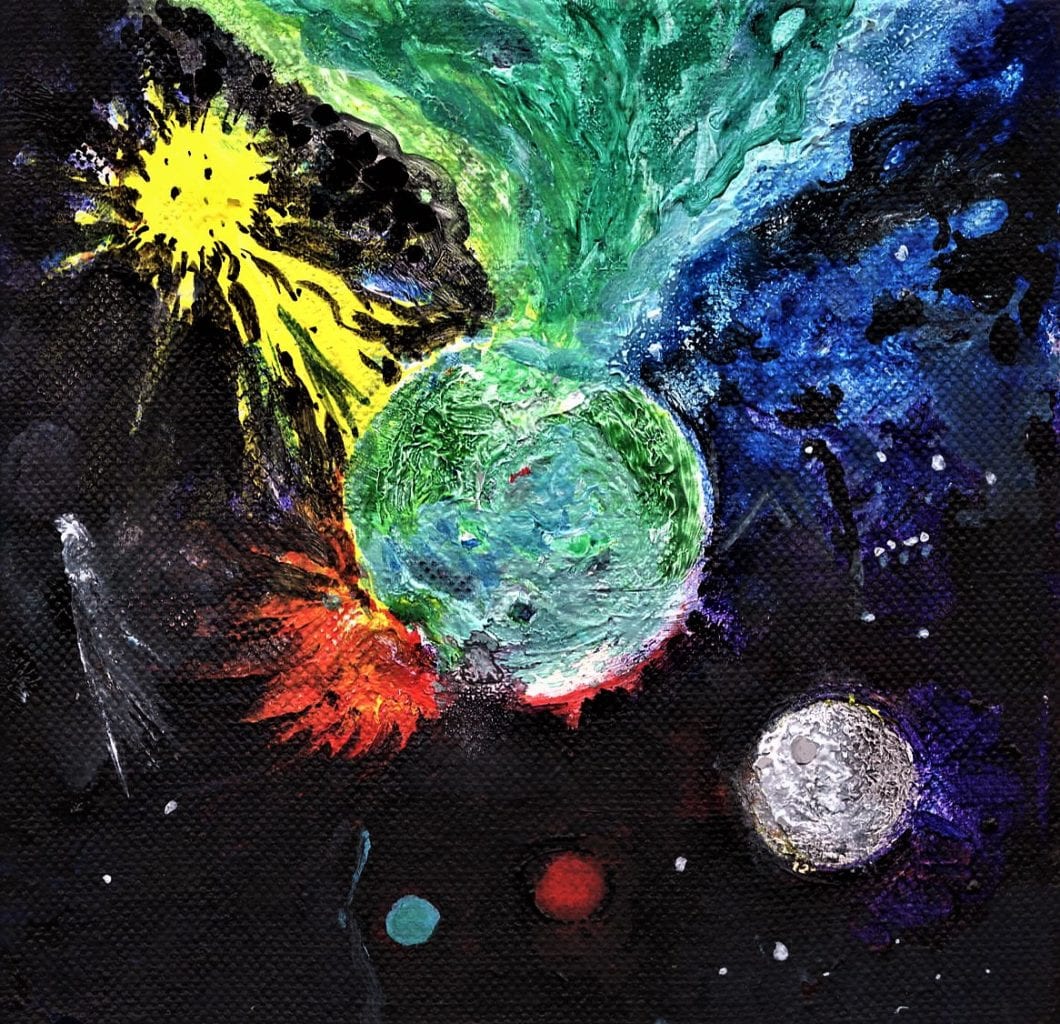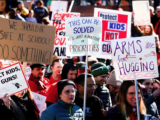
Earth Hanging in the Balance. A New American Journal graphic by Walter Simon [Art Market Place]
The Big Picture –
By Glynn Wilson –
At this sobering time in Earth history, perhaps we should take a moment on this milestone 50th anniversary of Earth Day to reflect a little on where we are as a people in our relationship to the planet.
(Earth Day is April 22. We are posting this a little early to get a head start in the Facebook algorithm).
The Gallup poll just released the latest data trend on public opinion about the environmental movement, and the findings are not exactly encouraging about the future.
Public views toward the so-called “Environmental Movement” have trended up and down over the years, always reflecting political and economic realities depending what’s going on in the world and the news.
With the global health crisis and economic disaster before us with the novel coronavirus dominating the news, it is clear why people might be more interested in health and economic issues at this time, although the long-term fate of the environment is interlinked with this crisis in indelible ways people may not be thinking about.
Nearly two-thirds of Americans say the environmental movement in the U.S. has definitely (20%) or probably (45%) done more good than harm, according to Gallup. That’s 65 percent.
That wording may surprise environmental activists and those who do their level best to live a low carbon footprint life, as I do.
Conversely, one-third think it has probably (25%) or definitely (8%) done more harm than good. That’s 33 percent.
What?
The combined percentage of those who think it has done more good than harm is down from 76 percent in Gallup’s first measurement from 1992.
Public support for the environmental movement has gone up and down over the years too. It might surprise you to see that only 18 percent of Americans characterize themselves as active participants in the environmental movement, and less than half the people, only 44 percent, say they are sympathetic to the movement but not active.
Another 30 percent are neutral toward the movement, while 7 precent report that they are totally unsympathetic.
Of course it is not surprising that Democrats and Democratic-leaning independents are much more likely than Republicans and Republican-leaning independents to say they are active participants.
These surveys found that 57 percent of Democrats and Democratic-leaning independents say they are sympathetic, with 30 percent claiming they are active.
Only 24 percent of Republicans and Republican-leaning independents say they are sympathetic, while only 14 percent report they are active.
Efforts to Support the Environment
Among a list of 15 actions that Americans can take to help the environment, majorities report that they have done seven of them in the past year.
Topping the list, 86 percent say they voluntarily recycle.
The least common actions are contacting a business to complain that its products are harmful to the environment (10%) and investing based on the environmental record of companies (8%).
Looking Back
The first Earth Day in 1970 was a big deal at the time. I was only 13-years-old, so I don’t remember much about it.
But by 1990, on the 20th anniversary, I was working as the first full-time reporter in Alabama at a chain of newspapers along the Gulf Coast covering the environment as a specialty beat.
After the Exxon-Valdez oil tanker ran aground in Prince Williams Sound Alaska every news outlet in the country, sensing a demand on the part of the public for news of this kind, started looking for reporters to specialize in covering it. I had clips related to this and an interest in the environment as a reporter and writer myself, so when the opportunity bus pulled up to the station to take a job doing this, I had my suitcase packed, got on the bus and moved to the beach in Gulf Shores.
For the better part of the next four years, as I talk about at length in my book, I had the incredible experience of covering a series of stories that demonstrated how the press (when done right) can play an important role in making democracy work.
Jump On The Bus: Make Democracy Work Again
Unfortunately, this movement began to unravel about the time of the first Gulf War, when even the New York Times fired environmental reporters, with one editor calling their coverage “too green.” I’m not making this up. There happens to be a bunch of academic literature documenting this, as I found out when I left Gulf Shores and moved to Tuscaloosa to take up studies at the University of Alabama as a graduate student in the Master’s program in Journalism and Communications.
I was mentored and advised to take the academic route into quantitative research, so my thesis was almost a doctoral dissertation, if not quite. The work was original and ground breaking and I was one of the first to show a correlation between public attitudes and concern for the environment, depending on how the news about the environment was being covered by the press.
Public Attitudes and Press Coverage of the Environment, 1968-1996
The theoretical basis of this work was something called “agenda-setting,” that is how the press sets the agenda for what the public says they are concerned about on public opinion surveys. Later I went on to work on a Ph.D. in Science Communication and Environmental Sociology at the University of Tennessee and got into the theoretical field of “framing” or how the news media frames issues and how that influences public opinion attitudes and concern.
Going Forward
Much has changed since then. And since I decided not to continue the research and teaching track to go back to work as a journalist and a web publisher, I’m not up to date on what the academic research shows now, although I get emails almost every day saying this work is still being cited.
The news business is in turmoil these days, with more news reporters losing their jobs every day and more newspapers going out of business, so there is much need for concern about how these important stories are going to be covered going forward.
Coronavirus continues to take its toll on the media industry
After spending all these years following and practicing this kind of journalism, what I can say is that without aggressive coverage of this stuff, public concern is not going to be there, meaning the influence environmentalists have on American politics and government will continue to shrink. This is a disaster.
While public concern for the environment is higher in some countries in Europe and around the world, in the United States, the Trump administration is openly hostile to the environment, as well as science itself. At the same time, Democrats, especially in the South, don’t seem to know how to make this a top agenda item in their appeals to the public for votes.
I just had a conversation this morning on Facebook Messenger with a national park ranger friend of mine who shares my concerns about this. All this talk about “getting back to normal” in a short period of time with the coronavirus still mutating and making people sick and killing them, no one, not even the New York Times, is talking about how we figure out how we are going to live different kinds of lives in the future in the wake of this crisis.
It just does not seem feasible at this point to be talking about going back to “business as usual” and doing things the way we have for too long now anyway. Human beings are having a direct, negative impact on the health of this planet, and we better start talking about how we are going to change — if we want to stay alive and survive on this planet.
There is a Silver Lining in the Coronavirus Crisis Dark Cloud
All I can do is try to tell people the story. Ignore it at your peril. I’ve done what I can do. Now “the people” need to do their part. Democracy doesn’t work without full public participation either. I know you are stressed out. So am I. Can we try to put that aside and help each other? Please?













